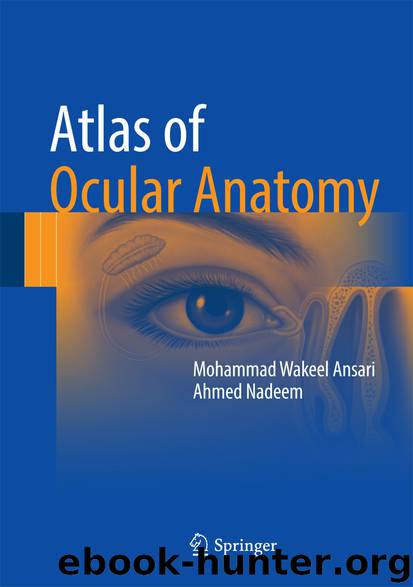Atlas of Ocular Anatomy by Mohammad Wakeel Ansari & Ahmed Nadeem

Author:Mohammad Wakeel Ansari & Ahmed Nadeem
Language: eng
Format: epub
Publisher: Springer International Publishing, Cham
Fig. 5.3Meibomian glands seen on everting the lids. They are at a right angle to the margin of the lid
The hard part of the lid is called the tarsus; it gives shape to the lid. It has an anterior and a posterior surface. Its upper border is connected to the superior orbital margin by a sheet of fascia called the septum orbitale in the upper lid. In the lower lid, it is the lower border of the tarsus, which is connected to the inferior orbital margin by the lower septum orbitale. The septum orbitale is not a rigid structure but a floating membrane that molds itself to the shape of the lid and moves with all the movements of the lid. In the upper lid, the upper septum orbitale is pierced by the superficial division of the tendon of the levator palpebrae superioris (LPS); in the lower lid, the lower septum is pierced by a prolongation of the inferior rectus muscle, called the inferior tarsal (Figs. 5.4 and 5.5) muscle. Just anterior to the opening of the meibomian gland is a gray line along which the lid can be vertically split into its anterior soft skin–muscle layer and the hard posterior tarso conjunctival layer by a knife. The innermost layer of the palpebral conjunctiva is adherent to the tarsus. The integrity of the three-layered tear film is maintained by the swab-like blinking movement of the upper lid, which spreads the tears on the front of the cornea and conjunctiva. Its outermost oily layer comes from the meibomian gland, which prevents any spilling of tears on the cheek. The middle watery layer comes from the main and accessory lacrimal glands. The innermost mucoid layer of tear film comes from mucus-secreting conjunctival glands. It keeps the cornea and conjunctiva moist and prevents their dehydration.
Fig. 5.4Septum orbitale (upper) pierced by the tendon of the LPS. Septum orbitale (lower) pierced by an extension from the insertion of the inferior rectus muscle
Download
This site does not store any files on its server. We only index and link to content provided by other sites. Please contact the content providers to delete copyright contents if any and email us, we'll remove relevant links or contents immediately.
| Administration & Medicine Economics | Allied Health Professions |
| Basic Sciences | Dentistry |
| History | Medical Informatics |
| Medicine | Nursing |
| Pharmacology | Psychology |
| Research | Veterinary Medicine |
Periodization Training for Sports by Tudor Bompa(7929)
Why We Sleep: Unlocking the Power of Sleep and Dreams by Matthew Walker(6362)
Paper Towns by Green John(4804)
The Immortal Life of Henrietta Lacks by Rebecca Skloot(4262)
The Sports Rules Book by Human Kinetics(4079)
Dynamic Alignment Through Imagery by Eric Franklin(3925)
ACSM's Complete Guide to Fitness & Health by ACSM(3827)
Kaplan MCAT Organic Chemistry Review: Created for MCAT 2015 (Kaplan Test Prep) by Kaplan(3804)
Introduction to Kinesiology by Shirl J. Hoffman(3628)
Livewired by David Eagleman(3535)
The River of Consciousness by Oliver Sacks(3420)
The Death of the Heart by Elizabeth Bowen(3342)
Alchemy and Alchemists by C. J. S. Thompson(3298)
Descartes' Error by Antonio Damasio(3167)
Bad Pharma by Ben Goldacre(3102)
The Emperor of All Maladies: A Biography of Cancer by Siddhartha Mukherjee(2932)
The Gene: An Intimate History by Siddhartha Mukherjee(2929)
The Fate of Rome: Climate, Disease, and the End of an Empire (The Princeton History of the Ancient World) by Kyle Harper(2877)
Kaplan MCAT Behavioral Sciences Review: Created for MCAT 2015 (Kaplan Test Prep) by Kaplan(2819)
